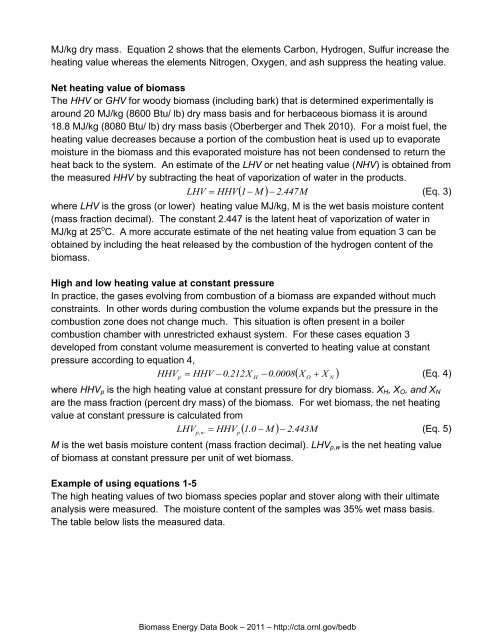Biomass Energy Data Book: Edition 4 - Full Document - Center for ...
Biomass Energy Data Book: Edition 4 - Full Document - Center for ...
Biomass Energy Data Book: Edition 4 - Full Document - Center for ...
You also want an ePaper? Increase the reach of your titles
YUMPU automatically turns print PDFs into web optimized ePapers that Google loves.
MJ/kg dry mass. Equation 2 shows that the elements Carbon, Hydrogen, Sulfur increase the<br />
heating value whereas the elements Nitrogen, Oxygen, and ash suppress the heating value.<br />
Net heating value of biomass<br />
The HHV or GHV <strong>for</strong> woody biomass (including bark) that is determined experimentally is<br />
around 20 MJ/kg (8600 Btu/ lb) dry mass basis and <strong>for</strong> herbaceous biomass it is around<br />
18.8 MJ/kg (8080 Btu/ lb) dry mass basis (Oberberger and Thek 2010). For a moist fuel, the<br />
heating value decreases because a portion of the combustion heat is used up to evaporate<br />
moisture in the biomass and this evaporated moisture has not been condensed to return the<br />
heat back to the system. An estimate of the LHV or net heating value (NHV) is obtained from<br />
the measured HHV by subtracting the heat of vaporization of water in the products.<br />
LHV HHV 1<br />
M 2.<br />
447<br />
(Eq. 3)<br />
M<br />
where LHV is the gross (or lower) heating value MJ/kg, M is the wet basis moisture content<br />
(mass fraction decimal). The constant 2.447 is the latent heat of vaporization of water in<br />
MJ/kg at 25 o C. A more accurate estimate of the net heating value from equation 3 can be<br />
obtained by including the heat released by the combustion of the hydrogen content of the<br />
biomass.<br />
High and low heating value at constant pressure<br />
In practice, the gases evolving from combustion of a biomass are expanded without much<br />
constraints. In other words during combustion the volume expands but the pressure in the<br />
combustion zone does not change much. This situation is often present in a boiler<br />
combustion chamber with unrestricted exhaust system. For these cases equation 3<br />
developed from constant volume measurement is converted to heating value at constant<br />
pressure according to equation 4,<br />
HHV HHV 0.<br />
212X<br />
0.<br />
0008 X X<br />
(Eq. 4)<br />
p<br />
H<br />
<br />
where HHVp is the high heating value at constant pressure <strong>for</strong> dry biomass. XH, XO, and XN<br />
are the mass fraction (percent dry mass) of the biomass. For wet biomass, the net heating<br />
value at constant pressure is calculated from<br />
HHV 1.<br />
0 M 2.<br />
443<br />
(Eq. 5)<br />
LHVp, w<br />
p<br />
O<br />
M<br />
M is the wet basis moisture content (mass fraction decimal). LHVp,w is the net heating value<br />
of biomass at constant pressure per unit of wet biomass.<br />
Example of using equations 1-5<br />
The high heating values of two biomass species poplar and stover along with their ultimate<br />
analysis were measured. The moisture content of the samples was 35% wet mass basis.<br />
The table below lists the measured data.<br />
<strong>Biomass</strong> <strong>Energy</strong> <strong>Data</strong> <strong>Book</strong> – 2011 – http://cta.ornl.gov/bedb<br />
N
















